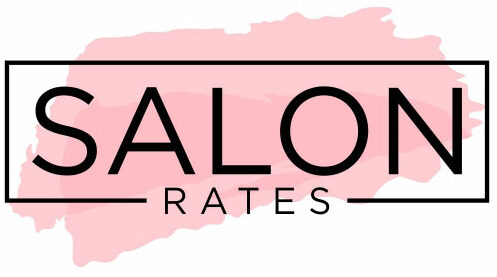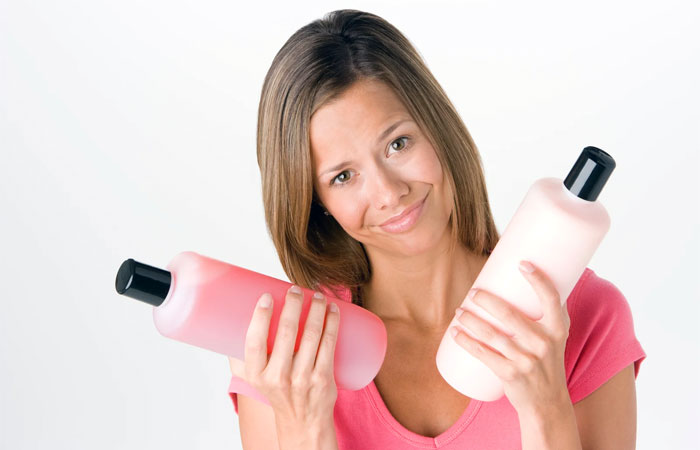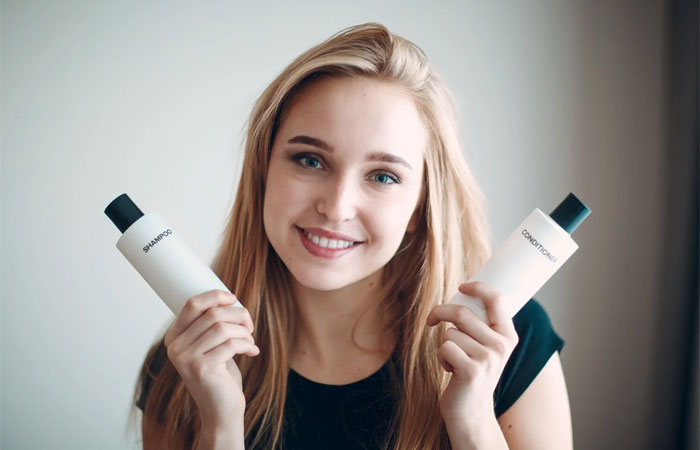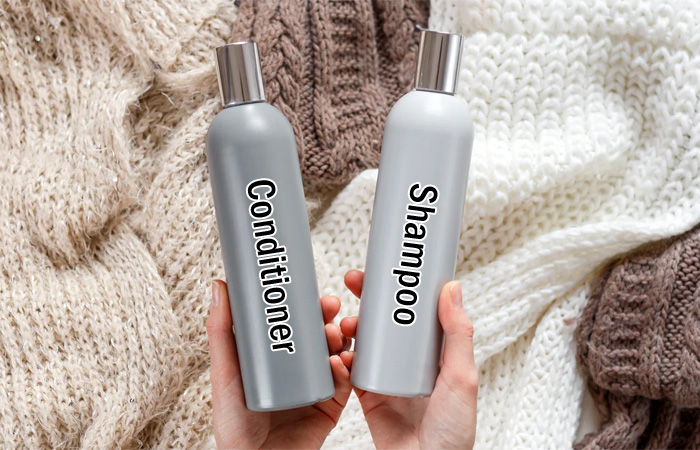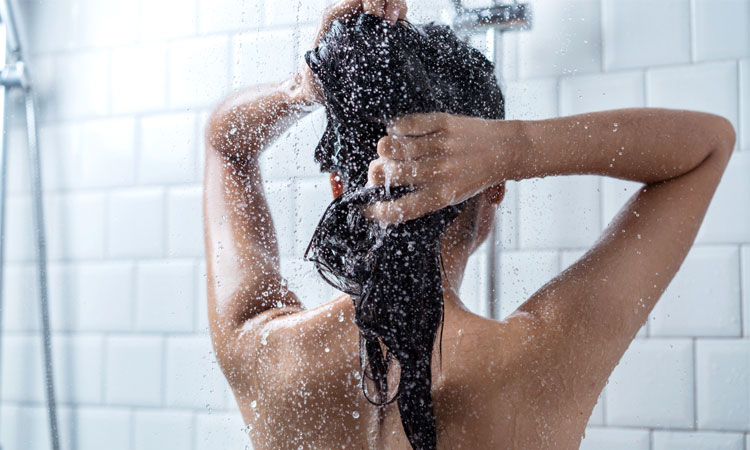New trends in hair care pop up all the time, but rarely is it one that changes the game entirely. For decades we have faithfully sudded up with shampoo and followed it with conditioner, until recently.
Reverse-washing has gotten such buzz and a large cult following that have many of us contemplating a switch from the traditional method to this game-changer. But, what exactly is reverse-washing, who is it for, and how do you know if you should change?
Follow along and we’ll take the mystery out of washing your hair and help you find the answer to whether you should use shampoo or conditioner first.
Table of Contents
Purpose of Shampoo
Shampoo’s job is to cleanse your hair of dirt and oils.
When you look at the back of your shampoo bottle, you’ll see things like sodium laureth sulfate, ammonium laureth sulfate, sodium lauryl sulfate, or ammonium lauryl sulfate on the ingredient list. In sulfate-free shampoos, it might be cocoamidopropyl betaine, decyl glucoside, or sodium methyl cocoyl taurate.
These are surfactants, and they’re the stars of the show. Surfactants are cleansing agents that emulsify the oils on your scalp and hair, allowing the water to wash them away. When you lather up, they work their magic and rinse dirt, oil, and impurities out of your hair.
See Also: 10 Benefits of Dry Shampoo
Purpose of Conditioner
Conditioner’s job is to add moisture to the hair.
The surfactants in shampoo wash away the oils from your hair and scalp. Your scalp will produce sebum which can keep it from being too dry, but that leaves the rest of your hair in need of moisture. Conditioner adds that moisture back into the hair, making strands feel soft and manageable.
Related: How Often Should You Use Conditioner?
To do its job and clean, shampoo is formulated with a higher, more alkaline pH. This makes the hair shaft swell as the cuticle opens. Conditioner is made with a lower pH that closes the roughed-up cuticle of the hair shaft, hydrating it and giving it “slip” so it doesn’t tangle as easily.
Method 1: “Shampoo First, Then Conditioner”
This is the traditional method that most people have used to wash their hair for years. Which shampoo and conditioner you use may change, but the basic steps do not.
There are a few things that can optimize this routine, like using lukewarm temperature water and making sure you gently squeeze out excess water after rinsing out the shampoo so it doesn’t dilute the conditioner. Though you can probably do it in your sleep, let’s go over the shampoo first method.
Step 1
Wet your hair thoroughly, all the way to the scalp. If there isn’t enough water, it will take more shampoo to create that thick lather we all love.
Though the bottle suggests you “lather, rinse, repeat”, most of the time we don’t let our hair get dirty enough to need a second washing.
Step 2
Once the shampoo has been rinsed out, follow it with a conditioner that best suits your hair’s needs. Conditioner is meant only for the ends of the hair and applying it to the scalp will lead to greasy, limp locks for those with fine hair.
While very dry, coarse, or curly hair won’t have greasy hair right away if they apply it at the roots, it will become greasy faster and could cause buildup on the scalp. No matter the hair type, conditioner is best if used from mid-shaft to ends.
The only thing that will change is the conditioner that you use, which you will choose based on your hair type.
Note: If you plan to try a black tea hair rinse, do so after shampoo and before conditioner.
Step 3
After letting the conditioner stay in and work its magic, rinse it out completely. Hair is most fragile when it’s wet, so you should gently blot hair dry with a towel instead of scrubbing.
This method works for just about everyone as long as they choose their products wisely. If you choose the wrong formula, it can leave hair dry, greasy, or even a combination of greasy roots and parched ends.
When compared to the conditioner first method, this is the better choice for those who struggle with frizz and dryness.
Method 2: “Conditioner First, Then Shampoo” (Reverse-Washing)
The reverse-washing method involves using conditioner first and then shampooing the hair. It can be a lifesaver for fine strands that get weighed down by conditioners or oily hair that looks greasy by the end of the day.
Beyond those with fine and oily hair, anyone who needs extra moisture can benefit from this method to some extent.
Years ago, co-washing emerged as a trend for keeping coarse, curly, or natural hair looking well hydrated. It involved using a cream conditioning wash to clean hair that would normally be extra dry or more prone to breakage when washed with typical shampoos.
However, this method of using conditioner instead of shampoo didn’t work as well for finer curls and less coarse natural hair. Using conditioner first, but following with shampoo is a great solution for people with dry hair or curls that co-washing didn’t work for.
It adds the same hydration that co-washing does but since it is followed with shampoo, removes the heavy conditioners at the scalp that can weigh hair down.
Here’s how to try the reverse-washing method.
Step 1
Use either your regular conditioner or a deep conditioning hair mask and apply to the ends of hair. This keeps the conditioners from coating the scalp, which will make it heavier and greasier faster.
The best way to know where to apply conditioner is to gather hair into a ponytail and coat only the ponytail with conditioner.
Related: How Often Should a Hair Mask Be Used?
Step 2
After letting the conditioner work its moisturizing magic for 2 to 5 minutes, wet the hair without rinsing completely.
Step 3
Shampoo as usual. As you wash it out, the surfactants in the shampoo will rinse away the residue that conditioners leave behind that can weigh hair down and make it greasy.
The reverse-washing method might not be for every hair type. Frizzy, coarse, and very dry hair should stick to the traditional shampoo first method or a modified version of reverse-washing.
Shampoo’s higher ph makes the hair shaft swell as the cuticle opens up and it stays open if not followed by a conditioner to close the cuticle again. That swelling of the hair shaft makes hair look thicker and is great for fine hair that can benefit from the added volume.
That same effect can make coarse, dry, or frizzy hair look and feel extra dry and frizzy. If this is your hair, there are ways to get the benefits of reverse-washing. One choice is to add a little conditioner in the ends before shampooing to soak up moisture and protect the ends, but also to use the conditioner after washing as usual.
Another trick to get the benefit of added hydration without the frizz that shampooing after conditioning will give you is to put a little hair oil in the ends of your hair before shampooing and conditioning as usual.
That will keep the shampoo from stripping too much moisture from the ends but won’t leave you with unmanageable hair.
The Bottom Line
If your goal is to have clean hair, you can’t go wrong with the traditional shampoo first method of washing. As long as you choose a shampoo and conditioner that suits your hair type, you can stick with your regular routine.
But, things become trends for a reason. Many people are raving about fuller hair and a lack of dry ends when using the reverse-washing method.
If your hair is fine or oily, using conditioner first just might be the thing to give your hair that fullness you crave. If you’re still unsure, you can experiment with both and see which yields the best results.
